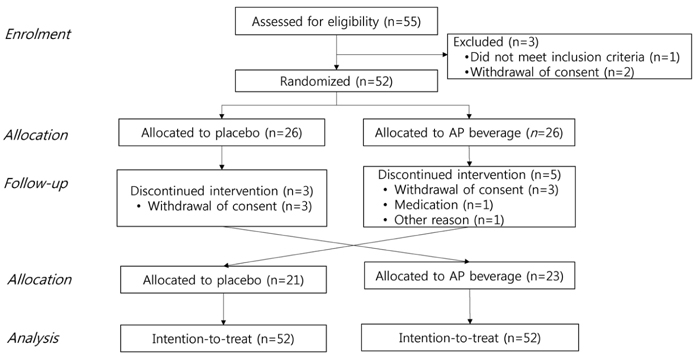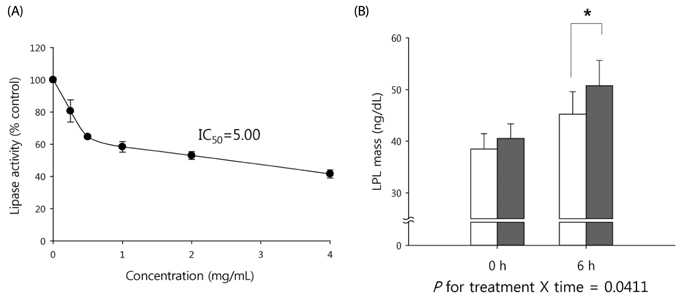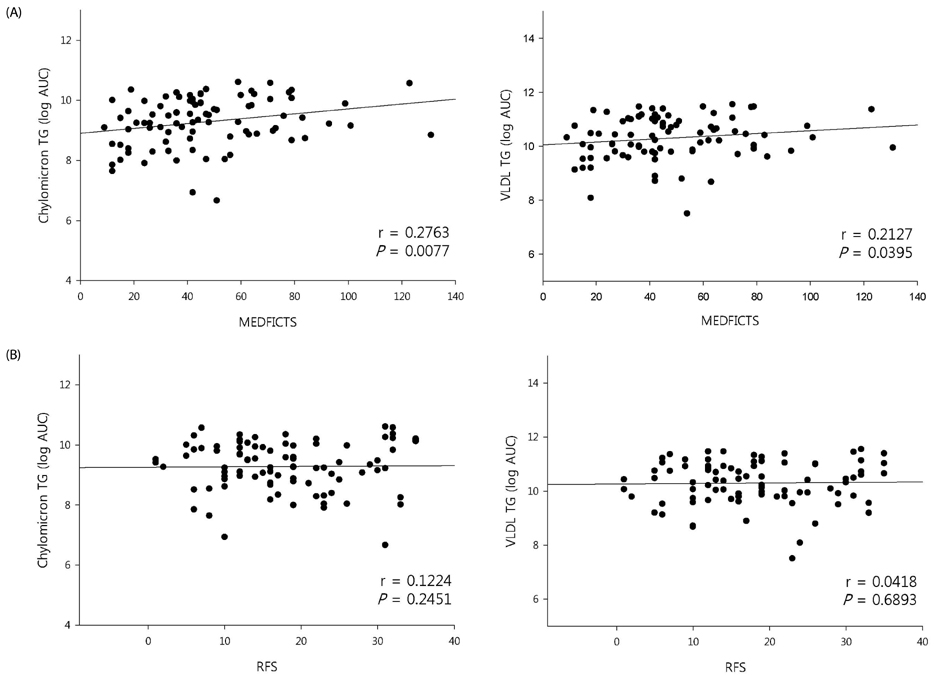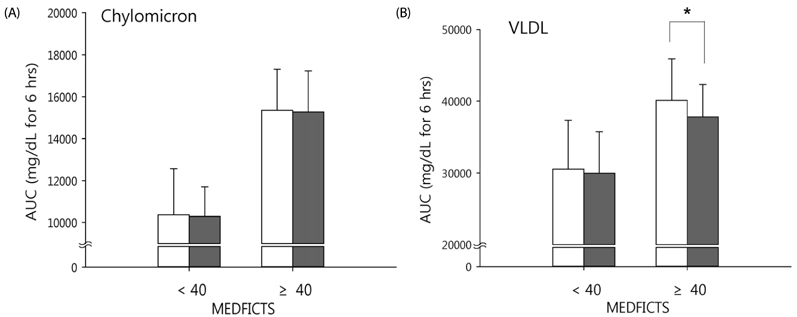Nutr Res Pract.
2018 Oct;12(5):371-377. 10.4162/nrp.2018.12.5.371.
Platycodi radix beverage ameliorates postprandial lipemia response through lipid clearance of triglyceride-rich lipoprotein: A randomized controlled study in healthy subjects with a high-fat load
- Affiliations
-
- 1Department of Nutritional Science and Food Management, Ewha Womans University, 52 Ewhayeodae-gil, Seodaemun-gu, Seoul 03760, Korea. orank@ewha.ac.kr
- 2Department of Agrofood Resources, Rural Development Administration National Institute of Agricultural Sciences, Jeonbuk 55365, Korea.
- 3BiofoodCRO. Ltd., Seoul 03721, Korea.
- KMID: 2446996
- DOI: http://doi.org/10.4162/nrp.2018.12.5.371
Abstract
- BACKGROUND/OBJECTIVES
Elevation of postprandial lipemia characterized by a rise in triglyceride (TG)-rich lipoproteins can increase the risk of atherogenesis. The objective of this study was to investigate postprandial lipemia response to a single dietary fat/sugar load test and monitor beneficial changes induced by the consumption of Platycodi radix (AP) beverage in healthy subjects.
SUBJECTS/METHODS
A total of 52 subjects were randomly assigned to either placebo or AP beverage group with a high-fat shake in a randomized controlled crossover trial. Postprandial blood was collected at 0, 1, 2, 4, and 6 h and analyzed for TG and lipoprotein lipase mass. Inhibition of pancreatic lipase was determined in vitro.
RESULTS
AP inhibited pancreatic lipase activity in vitro (IC₅₀ = 5 mg/mL). Compared to placebo beverage, AP beverage consumption with a high-fat shake induced significant increase of plasma lipoprotein lipase mass (P = 0.0111, β estimate = 4.2948) with significant reduction in very low-density lipoprotein (VLDL) TG concentration (P = 0.038, β estimate = −52.69) at 6 h. Based on significant correlation between high-fat dietary scores MEDFICTS and postprandial TG responses in VLDL (P = 0.0395, r = 0.2127), subgroup analysis revealed that 6 h-postprandial VLDL TG response was significantly decreased by AP consumption in subjects with MEDFICTS ≥ 40 (P = 0.0291, β estimate = −7214).
CONCLUSIONS
AP beverage might have potential to alleviate postprandial lipemia through inhibiting pancreatic lipase activity and elevating lipoprotein lipase mass. Subgroup analysis revealed that subjects with high-fat dietary pattern could be classified as responders to AP beverage among all subjects.
MeSH Terms
Figure
Reference
-
1. Hyson D, Rutledge JC, Berglund L. Postprandial lipemia and cardiovascular disease. Curr Atheroscler Rep. 2003; 5:437–444.
Article2. Bansal S, Buring JE, Rifai N, Mora S, Sacks FM, Ridker PM. Fasting compared with nonfasting triglycerides and risk of cardiovascular events in women. JAMA. 2007; 298:309–316.
Article3. Dias CB, Moughan PJ, Wood LG, Singh H, Garg ML. Postprandial lipemia: factoring in lipemic response for ranking foods for their healthiness. Lipids Health Dis. 2017; 16:178.
Article4. Lopez-Miranda J, Williams C, Lairon D. Dietary, physiological, genetic and pathological influences on postprandial lipid metabolism. Br J Nutr. 2007; 98:458–473.
Article5. Lee EB. Pharmacological studies on Platycodon grandiflorum A. DC. IV. A comparison of experimental pharmacological effects of crude platycodin with clinical indications of platycodi radix. Yakugaku Zasshi. 1973; 93:1188–1194.
Article6. Song JY, Lee GA, Yoon MS, Ma KH, Choi YM, Lee JR, Park HJ, Lee MC. Development and characterization of 22 polymorphic microsatellite markers for the balloon flower Platycodon grandiflorum (Campanulaceae). Genet Mol Res. 2012; 11:3263–3266.
Article7. Han LK, Xu BJ, Kimura Y, Zheng Y, Okuda H. Platycodi radix affects lipid metabolism in mice with high fat diet-induced obesity. J Nutr. 2000; 130:2760–2764.
Article8. Han LK, Zheng YN, Xu BJ, Okuda H, Kimura Y. Saponins from platycodi radix ameliorate high fat diet-induced obesity in mice. J Nutr. 2002; 132:2241–2245.
Article9. Zhao HL, Cho KH, Ha YW, Jeong TS, Lee WS, Kim YS. Cholesterol-lowering effect of platycodin D in hypercholesterolemic ICR mice. Eur J Pharmacol. 2006; 537:166–173.
Article10. Kim JY, Yang YJ, Yang YK, Oh SY, Hong YC, Lee EK, Kwon O. Diet quality scores and oxidative stress in Korean adults. Eur J Clin Nutr. 2011; 65:1271–1278.
Article11. Redgrave TG, Carlson LA. Changes in plasma very low density and low density lipoprotein content, composition, and size after a fatty meal in normo- and hypertriglyceridemic man. J Lipid Res. 1979; 20:217–229.
Article12. Xu BJ, Han LK, Zheng YN, Lee JH, Sung CK. In vitro inhibitory effect of triterpenoidal saponins from Platycodi Radix on pancreatic lipase. Arch Pharm Res. 2005; 28:180–185.
Article13. Purcell R, Latham SH, Botham KM, Hall WL, Wheeler-Jones CP. High-fat meals rich in EPA plus DHA compared with DHA only have differential effects on postprandial lipemia and plasma 8-isoprostane F2α concentrations relative to a control high-oleic acid meal: a randomized controlled trial. Am J Clin Nutr. 2014; 100:1019–1028.
Article14. McCrea CE, West SG, Kris-Etherton PM, Lambert JD, Gaugler TL, Teeter DL, Sauder KA, Gu Y, Glisan SL, Skulas-Ray AC. Effects of culinary spices and psychological stress on postprandial lipemia and lipase activity: results of a randomized crossover study and in vitro experiments. J Transl Med. 2015; 13:7.
Article15. Thomsen C, Rasmussen O, Lousen T, Holst JJ, Fenselau S, Schrezenmeir J, Hermansen K. Differential effects of saturated and monounsaturated fatty acids on postprandial lipemia and incretin responses in healthy subjects. Am J Clin Nutr. 1999; 69:1135–1143.
Article16. Westphal S, Orth M, Ambrosch A, Osmundsen K, Luley C. Postprandial chylomicrons and VLDLs in severe hypertriacylglycerolemia are lowered more effectively than are chylomicron remnants after treatment with n-3 fatty acids. Am J Clin Nutr. 2000; 71:914–920.
Article17. Wong H, Schotz MC. The lipase gene family. J Lipid Res. 2002; 43:993–999.
Article18. Birari RB, Bhutani KK. Pancreatic lipase inhibitors from natural sources: unexplored potential. Drug Discov Today. 2007; 12:879–889.
Article19. Loli H, Narwal SK, Saun NK, Gupta R. Lipases in medicine: an overview. Mini Rev Med Chem. 2015; 15:1209–1216.
Article20. Zhao HL, Kim YS. Determination of the kinetic properties of platycodin D for the inhibition of pancreatic lipase using a 1,2-diglyceride-based colorimetric assay. Arch Pharm Res. 2004; 27:968–972.
Article21. Otarod JK, Goldberg IJ. Lipoprotein lipase and its role in regulation of plasma lipoproteins and cardiac risk. Curr Atheroscler Rep. 2004; 6:335–342.
Article22. Kris-Etherton P, Eissenstat B, Jaax S, Srinath U, Scott L, Rader J, Pearson T. Validation for MEDFICTS, a dietary assessment instrument for evaluating adherence to total and saturated fat recommendations of the National Cholesterol Education Program Step 1 and Step 2 diets. J Am Diet Assoc. 2001; 101:81–86.
Article
- Full Text Links
- Actions
-
Cited
- CITED
-
- Close
- Share
- Similar articles
-
- Sour cherry ameliorates hepatic lipid synthesis in high-fat diet-induced obese mice via activation of adenosine monophosphate-activated protein kinase signaling
- Postprandial Lipid Concentrations and Daytime Biological Variation of Lipids in a Healthy Chinese Population
- Effects of a low glycemic load diet on body weight loss in overweight or obese young adults
- The Correlation between the Triglyceride to High Density Lipoprotein Cholesterol Ratio and Computed Tomography-Measured Visceral Fat and Cardiovascular Disease Risk Factors in Local Adult Male Subjects
- The effect of duck meat treated with turmeric powder intake on the postprandial blood lipid profiles in female university students






